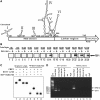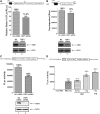Far upstream element binding protein 1 binds the internal ribosomal entry site of enterovirus 71 and enhances viral translation and viral growth
- PMID: 21880596
- PMCID: PMC3239202
- DOI: 10.1093/nar/gkr682
Far upstream element binding protein 1 binds the internal ribosomal entry site of enterovirus 71 and enhances viral translation and viral growth
Abstract
Enterovirus 71 (EV71) is associated with severe neurological disorders in children, and has been implicated as the infectious agent in several large-scale outbreaks with mortalities. Upon infection, the viral RNA is translated in a cap-independent manner to yield a large polyprotein precursor. This mechanism relies on the presence of an internal ribosome entry site (IRES) element within the 5'-untranslated region. Virus-host interactions in EV71-infected cells are crucial in assisting this process. We identified a novel positive IRES trans-acting factor, far upstream element binding protein 1 (FBP1). Using binding assays, we mapped the RNA determinants within the EV71 IRES responsible for FBP1 binding and mapped the protein domains involved in this interaction. We also demonstrated that during EV71 infection, the nuclear protein FBP1 is enriched in cytoplasm where viral replication occurs. Moreover, we showed that FBP1 acts as a positive regulator of EV71 replication by competing with negative ITAF for EV71 IRES binding. These new findings may provide a route to new anti-viral therapy.
© The Author(s) 2011. Published by Oxford University Press.
Figures










Similar articles
-
Far upstream element binding protein 1: a commander of transcription, translation and beyond.Oncogene. 2013 Jun 13;32(24):2907-16. doi: 10.1038/onc.2012.350. Epub 2012 Aug 27. Oncogene. 2013. PMID: 22926519 Free PMC article. Review.
-
Nuclear Protein Sam68 Interacts with the Enterovirus 71 Internal Ribosome Entry Site and Positively Regulates Viral Protein Translation.J Virol. 2015 Oct;89(19):10031-43. doi: 10.1128/JVI.01677-15. Epub 2015 Jul 22. J Virol. 2015. PMID: 26202240 Free PMC article.
-
Additive Promotion of Viral Internal Ribosome Entry Site-Mediated Translation by Far Upstream Element-Binding Protein 1 and an Enterovirus 71-Induced Cleavage Product.PLoS Pathog. 2016 Oct 25;12(10):e1005959. doi: 10.1371/journal.ppat.1005959. eCollection 2016 Oct. PLoS Pathog. 2016. PMID: 27780225 Free PMC article.
-
Far upstream element binding protein 2 interacts with enterovirus 71 internal ribosomal entry site and negatively regulates viral translation.Nucleic Acids Res. 2009 Jan;37(1):47-59. doi: 10.1093/nar/gkn901. Epub 2008 Nov 14. Nucleic Acids Res. 2009. PMID: 19010963 Free PMC article.
-
Host factors in enterovirus 71 replication.J Virol. 2011 Oct;85(19):9658-66. doi: 10.1128/JVI.05063-11. Epub 2011 Jun 29. J Virol. 2011. PMID: 21715481 Free PMC article. Review.
Cited by
-
Far upstream element binding protein 1: a commander of transcription, translation and beyond.Oncogene. 2013 Jun 13;32(24):2907-16. doi: 10.1038/onc.2012.350. Epub 2012 Aug 27. Oncogene. 2013. PMID: 22926519 Free PMC article. Review.
-
The master regulator FUBP1: its emerging role in normal cell function and malignant development.Cell Mol Life Sci. 2019 Jan;76(2):259-281. doi: 10.1007/s00018-018-2933-6. Epub 2018 Oct 20. Cell Mol Life Sci. 2019. PMID: 30343319 Free PMC article. Review.
-
The splicing factor FUBP1 is required for the efficient splicing of oncogene MDM2 pre-mRNA.J Biol Chem. 2014 Jun 20;289(25):17350-64. doi: 10.1074/jbc.M114.554717. Epub 2014 May 5. J Biol Chem. 2014. PMID: 24798327 Free PMC article.
-
SIRT1 inhibits EV71 genome replication and RNA translation by interfering with the viral polymerase and 5'UTR RNA.J Cell Sci. 2016 Dec 15;129(24):4534-4547. doi: 10.1242/jcs.193698. Epub 2016 Nov 14. J Cell Sci. 2016. PMID: 27875274 Free PMC article.
-
Tribbles pseudokinase 3 promotes enterovirus A71 infection via dual mechanisms.Emerg Microbes Infect. 2024 Dec;13(1):2307514. doi: 10.1080/22221751.2024.2307514. Epub 2024 Jan 30. Emerg Microbes Infect. 2024. PMID: 38240287 Free PMC article.
References
-
- McMinn PC. An overview of the evolution of enterovirus 71 and its clinical and public health significance. FEMS Microbiol. Rev. 2002;26:91–107. - PubMed
-
- Ho M, Chen ER, Hsu KH, Twu SJ, Chen KT, Tsai SF, Wang JR, Shih SR. An epidemic of enterovirus 71 infection in Taiwan. Taiwan Enterovirus Epidemic Working Group. N. Engl. J. Med. 1999;341:929–935. - PubMed
-
- Lin TY, Chang LY, Hsia SH, Huang YC, Chiu CH, Hsueh C, Shih SR, Liu CC, Wu MH. The 1998 enterovirus 71 outbreak in Taiwan: pathogenesis and management. Clin. Infect. Dis. 2002;34(Suppl. 2):S52–S57. - PubMed
-
- Gilbert GL, Dickson KE, Waters MJ, Kennett ML, Land SA, Sneddon M. Outbreak of enterovirus 71 infection in Victoria, Australia, with a high incidence of neurologic involvement. Pediatr. Infect. Dis. J. 1988;7:484–488. - PubMed
-
- Kehle J, Roth B, Metzger C, Pfitzner A, Enders G. Molecular characterization of an enterovirus 71 causing neurological disease in Germany. J. Neurovirol. 2003;9:126–128. - PubMed
Publication types
MeSH terms
Substances
LinkOut - more resources
Full Text Sources
Other Literature Sources
Research Materials
Miscellaneous

